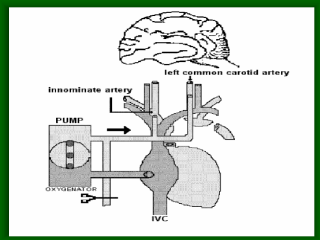 |
A technique that
uses partial selective antegrade perfusion (SCP) with aortic arch aneurysms was described
in the 1980s (Frist et al.1986). The SCP involves distal clamping of the aorta along with
cannulation of the innominate, the left common carotid, and subclavian arteries. These
arteries are perfused in an antegrade fashion in order to take advantage of the intrisic
cerebral autoregulation of blood flow that ensures a constant supply of oxygen over a
broad range of metabolic demands and hydrostatic pressures (Ergin ey al.1994).The current
trend is to perfuse at least the innominate and left carotid arteries with a dedicated
pump in a system with flows determinded by trget presures measured at distal sites. A
system of low flow and profoundly hypothermic cerebral perfusion used while keeping the
rest of body at moderate hypothermia in attempt to reduce the time required for pump
rewarming (Bachet ey al.1991).
Selective cerebral perfusion extends the
"safe"period during which conventional systemic perfusion may be interrupted and
reduces the risk of cerebral ischemia. ( Matsuda ey al.1989).
Preservation of the cerebral autoregulatory system by SCP alloows for longer
periods of aortic arch repair. Any impairment of this autoregulation may lead to
reperfusion injuries associated with regional over - and under-perfusion of the affected
cerebral areas (Ergin et al.1994). Selective cerebral perfusion is more complicated
technically than hypothermic circulatory arrest. Additional time and manipulation are
required to isolate and cannulate the arch branches, and this may damage fragile arteries
or dislodge atheromatous debris into the cerebral circulation. The use of SCP is limited
in patients with severe carotid or brachiocephalic desease,traumatic aortic aneurysms,
aortic rupture, infection or aortic dissection involving arch vessels, in patient with
previous aortic, cardiac or mediastinal operations, or for thouse who require arrest
before performing a sternotomy (Frist et al. 1986). |
